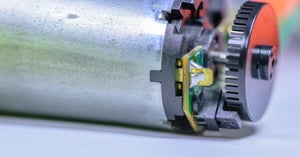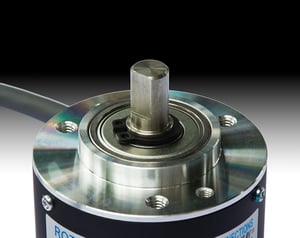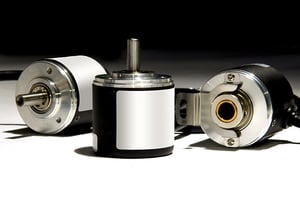 An Encoder is a device, circuit, transducer, software program, or algorithm that converts information from one format or code to another, for the purpose of determining position, speed, or direction.
An Encoder is a device, circuit, transducer, software program, or algorithm that converts information from one format or code to another, for the purpose of determining position, speed, or direction.
To say there are many different types of encoders would be an understatement. There are linear and rotary encoders that can be further categorized as incremental and absolute encoders. Incremental and absolute encoders can be further broken down into optical or magnetic. Each of these encoders have a similar goal; to generate a signal that is sent to a controller to have the machinery perform its specific function. They have their different capabilities which is what leads to the many different types of encoders.
A linear encoder can be defined as an encoder that responds to motion along a path. Its sensor reads the scale and converts position into an analog or digital signal that is transformed into a digital readout. This is done to convert motion into digital or analog signals to determine the change in position over time.
Rotary encoders respond to rotational motion. Disks, light sources, detectors, and electronics make up a rotary encoder. Circles of all different patterns can be found etched into each rotary encoder. The light uniquely scans the etched disk which gathers a signal through the interruption of light. Once the signal is gathered it is sent to on output device which provides feedback of the position and/or velocity.
 These two types of encoders can be further broken down into incremental and absolute encoders.
These two types of encoders can be further broken down into incremental and absolute encoders.
Incremental encoders use their movement to generate high and low pulses that indicate movement from one position to the next. Every time incremental encoders move, a pulse is sent out, after moving along its desired path the pulses are added up by a counter which then in turn provide information regarding positioning or speed. For a linear incremental encoder, the same functions would be performed but limited to movement on a linear path. If it were a rotary incremental encoder it would calculate rotational motion. This encoder doesn’t have the ability to calculate the specific position, only that the position has changed.
An absolute encoder indicates not only position change but also the position relative to shaft rotation. Absolute encoders are known for being more accurate than incremental encoders. This is because they do not need the knowledge of any previous positions. Absolute encoders also have their own types of encoders. Single turn absolute encoders provide information for any increment within one shaft rotation. Multi-turn absolute encoders retain absolute position data over the course of multiple shaft rotations. If exact position is needed, absolute encoders would be the best type of encoder to provide that.
 Encoders can be further categorized into optical and magnetic encoders. Optical encoders use the interruption of the beam of light to produce a signal. Magnetic encoders rely on alternating positive and negative magnetic poles.
Encoders can be further categorized into optical and magnetic encoders. Optical encoders use the interruption of the beam of light to produce a signal. Magnetic encoders rely on alternating positive and negative magnetic poles.
For all the many different types of encoders, there are many different types of manufacturing industries that utilize them. If a process includes the need for measuring distance, position or speed, encoders will be used. Industries such as packaging, filling, conveying, cut-to-length, and flow control can all be aided by the measuring assistance encoders provide. Printing, binding, textile mills, automotive, agriculture, oil and chemical, metal roll forming, tolling machinery, paper and food mills also use encoders. As an integral part of any processing operation, encoders create an environment of efficiency and accuracy, regardless of the industry.

Manufacturing & Factory Automation Specialists
Spare Parts – Engineered Solutions – Custom Products – Control Repair


